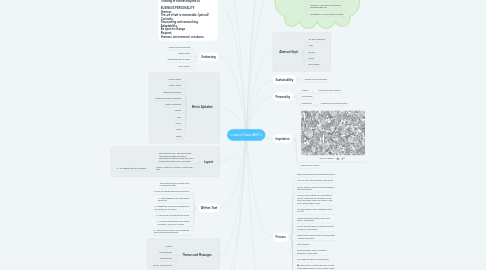Lower Case ABC's
by Jasmine Bashaj


1. Devanagari
2. Simplicity. breaking stuff down, making stuff simple, understandable and digestible. Creativity. To be interpreted as problem solving. Transparency. laying out all of the facts in the beginning Sustainability. Thinking of futures beyond us BUSINESS PERSONALITY Humour. The art of wit is memorable. (period) Curiosity. Discovering and researching. Adaptability. Be open to change Respect. Humans, environment, creatures.
3. Colours
3.1. 3 schemes per letter
3.2. Olimpia Zagnolia
4. Textures (in relation to themes and story on page)
4.1. natural Fabrics
4.1.1. Linen
4.1.2. bamboo
4.1.3. vegan suede
4.1.4. recycled water bottle fleece
4.2. natural elements
5. Scents
5.1. Rosemary Essential Oil - Improves memory, increases alertness
5.2. Vetiver - Improves brain function, increases concentration - participants with ADHA had improved brain patterns and decreased stmptoms
5.3. Lemon - arouses senses, decreases errors
5.4. Peppermint - Sustains attention, Enhances memory accuracy
5.5. Lavender - improves concentration, recharges the brain
5.6. Lemongrass - reduces stress & anxiety
6. Embossing
6.1. Raised or engraved style
6.2. hidden letters
6.3. interesting levels of paper
6.4. paper texture
7. Ethnic Alphabet
7.1. Roman Letters
7.2. Arabic Letters
7.3. Japanese Characters
7.4. Simplified Chinese Characters
7.5. Korean Characters
7.6. Hebrew
7.7. Tamil
7.8. Cyrillic
7.9. Greek
7.10. Braille
8. Abstract Style
8.1. Art deco reference
8.2. clean
8.3. modern
8.4. simple
8.5. large shapes
9. Layout
9.1. Asymmetrical Grid - Paul Rand's idea; The eye works harder to resolve asymmetrical relations in the brain, thus making this design more memorable.
9.2. Uneven number of columns 5 columns by 7 rows
9.2.1. A - An alligator ate the ants apple.
10. Written Text
10.1. Each letter will tell a minimal story including the letter
10.2. E- Eliot the elephant had an ear infection
10.3. H - the hedgehog's hair was beyond handsome
10.4. M -Maggie the friendly microorganism is not allowed on my muffin.
10.5. O - the oracle orca watches the ozone
10.6. P - the pike accidentally ate a plastic pineapple, now he’s in a pickle.
10.7. R - Rita the Rino loves to smell Rosemary trees to help with memories
11. Themes and Messages
11.1. Nature
11.2. animal welfare
11.3. Sustainability
11.4. reduce, reuse, recycle
12. Sustainability
12.1. Printed on recycled paper
13. Accessibility
13.1. Colour Blind
13.2. Sensory
13.3. Braille for Blind
13.4. Different alphabets for relatable recognition
14. Personality
14.1. Friendly
14.1.1. Smooth/rounded corners
14.2. Comfortable
14.3. Stimulating
14.3.1. Bright fun and inviting colours
